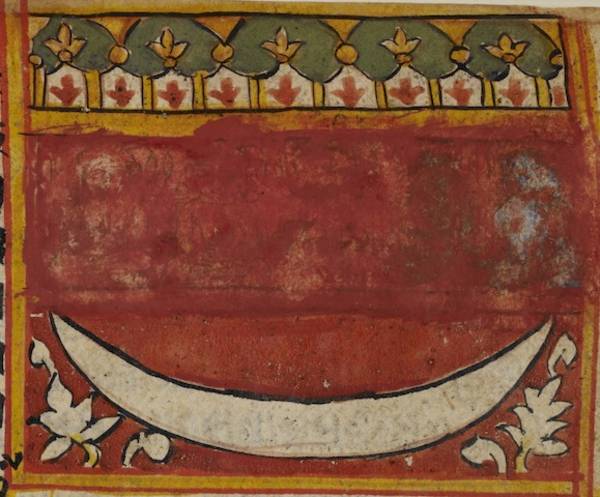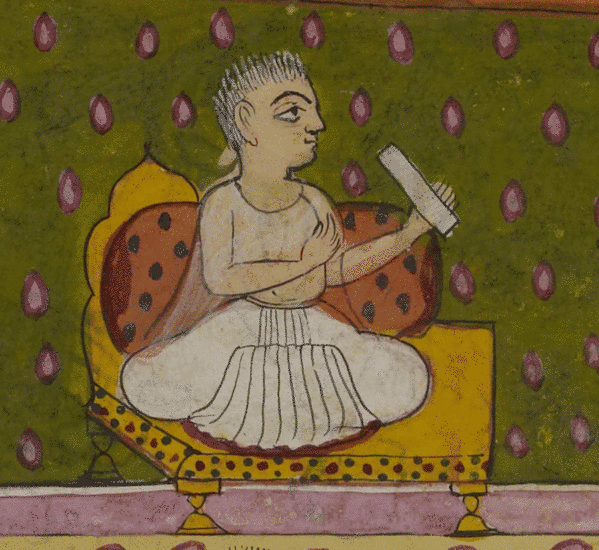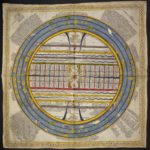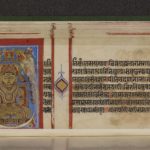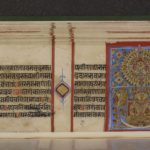Article: Liberation
The definitive aim of the Jain religion is the final liberation of the soul – mokṣa – from the cycle of birth. Jains believe that the soul is caught in the cycle of rebirth – saṃsāra – and can only attain liberation when it is free of all karma.
Also called salvation or emancipation, liberation is achieved after a long process, which can last thousands of years or longer in the cycle of time. The soul is trapped within different bodies by karma, which binds to it and weighs it down. Produced by activities, karma affects the type of body into which a soul is born, and its condition. After the death of that body, the soul takes birth in another body. This process repeats – called the cycle of birth – and ends only when a soul has no karma. When its body dies, the soul is then released from all flesh instead of being reborn. This event is reaching liberation. After emancipation, the soul exists in the siddha-śilā.
The path to liberation is found in the scriptures, which record the teachings of the Jinas. Two concepts in particular guide Jains towards liberation. The ‘three gems’ – ratna-traya – summarises Jain doctrine in a set of three easily recalled phrases while the ‘scale of perfection’ – guṇa-sthāna – lays out the route to salvation in 14 steps.
Of all the beings in the universe, only human beings can be liberated. Jains agree that only mendicants can observe the level of detachment necessary for emancipation but there are sectarian differences over whether women can be liberated.
The Jain faith has similar theories to those found in other religions that originated in India. However, the major concepts in Jainism are unique, differing in key aspects from those of Buddhism and Hinduism.
This piece is a summary of the article "Liberation". The full article will be available soon.
Moving towards liberation
As one of the principal concepts in the Jain faith, liberation – mokṣa – needs to be considered alongside the closely related concepts of the soul, karma and rebirth.
The soul or self – jīva – in Jainism can be thought of consciousness or sentience. It is found in all living beings, and those objects that are not alive are ajīva – without consciousness. Each individual soul is embodied within one of all the various types of different living beings and is destined to be born into a new body when the present one dies. This process continues over eternity in what is called the cycle of rebirth – saṃsāra. The body to which the soul moves depends on the karma the soul has gathered in previous lifetimes. The soul reaches emancipation only when it has no karmas attached to it.
The soul is trapped in the cycle of birth by the karmas that are bound to it. Generated by the activities of mind, speech and behaviour, karmas arise from passions – kaṣāyas – aroused by attachments to the world. Karma can be burnt away from the soul by asceticism – tapas – such as fasting, and by spiritual practices, such as meditation. Detachment from worldly concerns helps stop new karmas being formed.
Spiritual development is not a smooth path. The interplay of karmas and the choices of living beings can result in birth as a spiritually advanced being being followed by life as a lowly being, perhaps even a hell creature. Therefore the soul usually takes numerous lives to progress spiritually to the point of having no karma. When it is competely free of karma, it becomes enlightened – kevala-jñāna. This perfect knowledge comes from the soul’s realisation of its true nature and is the necessary step before liberation.
Liberation
Jains believe that a soul can become omniscient while it is within a living body. When the human being dies, the soul is not immediately reborn within another body. Instead, it is instantly emancipated from the cycle of births and regains its full nature, which is perfection. This is the moment of mokṣa.
The liberated soul – siddha – flies to the very top of the occupied universe – loka-ākāśa – to join the other emancipated souls.
All of the siddhas dwell together in the siddha-śilā. Also called the siddha-loka or īśat-prāgbhārā-bhūmi, it is commonly represented in Jain art as a horizontal crescent shape. There each siddha remains a separate soul and experiences absolute bliss for infinity.
Guidance of the Jinas
The 24 Jinas are considered to have revealed the unchanging truths of the world, which include the path to salvation. The followers of the Jinas – the Jains – can find the route to liberation in the scriptures and in the examples set by the Jinas themselves.
The notion of the ‘three gems’ or ‘three jewels‘ – ratna-traya – summarises Jain doctrine, namely:
- accepting the Jinas’ teachings
- fully grasping Jain principles
- living in accordance with these tenets.
The ‘fourth gem’ of austerities stresses the importance of ascetic practices in destroying karma.
The ‘scale of perfection’ – guṇa-sthāna – sets out the different stages of spiritual development in terms of the connected beliefs and practices. These two frameworks are key to observing the precepts of the Jain faith and progressing towards liberation.
Who can be liberated
Nearly all souls have the capacity – bhavyatva – to achieve liberation. However, some souls are abhavya and can never attain salvation.
Even those souls that are bhavya can reach emancipation only under certain conditions. Since only human beings can be liberated, even souls born as the higher gods, who are very spiritually advanced, must be born into human bodies to be emancipated. Not all human beings can reach liberation, however.
Only human beings who follow the path to salvation set out by the Jinas can be liberated. Of the followers of the Jinas, only mendicants can attain emancipation. This is because only mendicants are believed capable of maintaining the levels of detachment from worldly concerns that is required to keep karma from being produced and binding to the soul.
Lay Jains have responsibilities to their families and communities that mean they cannot practise the sufficient detachment. In Jain literature, it is true that lay people are depicted reaching emancipation but only the perfect lay Jain is able to meet the challenges involved in attaining liberation.
Sectarian differences
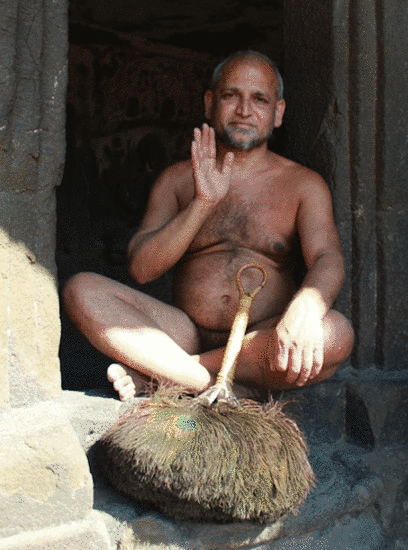
Digambara monk
Image by Arian Zwegers © CC BY 2.0
The two major Jain sects have contrasting views regarding the emancipation of women.
Digambara texts state that souls cannot be liberated in their rebirth as women because they are incapable of reaching the same level of detachment as men. This revolves around the ideal of mendicant nudity. Fully fledged Digambara monks – munis – go naked, rejecting clothing as an attachment to the world and because they believe the Jinas lived naked. The women who become nuns – āryikās – in the Digambara tradition are not permitted to go naked so are technically spiritually advanced lay women, not mendicants.
The Śvetāmbara sect, however, regards both men and women as having the capacity for liberation. Śvetāmbaras regard clothing for mendicants as necessary for life and do not consider wearing it a sign of attachment. Both their monks and nuns wear white clothes and are believed to be able to achieve liberation.
Indian religions and the soul
Along with other religions that originated in India, such as Hinduism and Buddhism, Jains believe that souls:
- are trapped in the neverending cycle of rebirth – saṃsāra
- are reborn in different bodies according to the karma they have collected
- can only break out of the cycle of rebirth by being born a human being, achieving enlightenment and then, leaving the body behind, reaching liberation
- with karma attached to them can never be enlightened – the bondage of karma.
The Jain concepts of the soul and karma differ from those of the other Indian faiths, however. In Jainism souls are individual with the same innate qualities. They accrue karmas that are bound to them throughout the cycle of birth until they mature and fall away. Souls remain individual once they are perfected.
Followers of the Buddha do not believe in a soul in the same way as Jains and Hindus. The Buddha preached anatta – the doctrine of no soul – and that the cycle of birth involves a transfer of consciousness from one body to another, influenced by karma. Nirvāṇa is the term usually used for liberation or salvation – in which followers of the Buddha realise that there is neither self nor consciousness. It describes the extinguishing of the ‘fires’ of attachment, aversion and ignorance that cause suffering. Enlightened souls thus gain release from the cycle of births when they die – mokṣa – instead of another rebirth.
There is a variety of belief among Hindu traditions, although most Hindus believe in the soul or self – ātman – and liberation. Broadly, for Hindus ignorance of the true self or soul creates desire for and enjoyment of the world, which traps the soul in the cycle of birth. Karma comes from thoughts, words and deeds, and influences future lives. Between two births, the soul goes either to hell, to be punished for bad actions, or to heaven, where it enjoys rewards for good actions. Hindu mokṣa is the perfecting of the soul and release from the cycle of rebirths, although various schools differ on whether realisation of the soul can be achieved during or after life.
Reading
- The Jains
Paul Dundas - Library of Religious Beliefs and Practices series; series editor John Hinnels and Ninian Smart; volume 14
Routledge Curzon Press; London, UK; 2002
- The Jaina Path of Purification
Padmanabh S. Jaini - University of California Press; Berkeley, California USA; 1979
- Gender and Salvation: Jaina Debates on the Spiritual Liberation of Women
Padmanabh S. Jaini - University of California Press; Berkeley, California, USA; 1991
- ‘Bhavyatva and Abhavyatva: a Jaina Doctrine of Predestination’
Padmanabh S. Jaini - Collected Papers on Jaina Studies
Motilal Banarsidass; New Delhi, India; 2000
- ‘Indian Perspectives on the Spirituality of Animals’
Padmanabh S. Jaini - Collected Papers on Jaina Studies
Motilal Banarsidass; New Delhi, India; 2000
- ‘From Nigoda to Mokṣa: The Story of Marudevī’
Padmanabh S. Jaini - Jainism and Early Buddhism in the Indian Cultural Context: Essays in Honor of Padmanabh S. Jaini
edited by Olle Qvarnström
Asian Humanities Press; Fremont, California, USA; 2003
- Commentary on Tattvārtha Sūtra of Vācaka Umāsvāti
Pandit Sukhlalji - translated by K. K. Dixit
L. D. series; volume 44
L. D. Institute of Indology; Ahmedabad, Gujarat, India; 1974
- Historical Dictionary of Jainism
Kristi L. Wiley - Historical Dictionaries of Religions, Philosophies, and Movements series; series editor Jon Woronoff; volume 53
Scarecrow Press; Maryland, USA; 2004
- +
- aAbhavya
- aAbhinandana
- aAbhiṣeka
- aĀcāra
- aĀcārāṅga-sūtra
- aĀcārya
- aAchalbhrata
- aAḍhāī-dvīpa
- aAdharma
- aAdho-loka
- aAdhyayana
- aAdvaita Vedānta
- aĀgama
- aAghātīya
- aAghātīya-karman
- aAgnibhuti
- aAgra
- aĀhāra
- aAhiṃsā
- aAhimsa Day
- aAjita
- aAjīva
- aAkampit
- aĀkāśa
- aAkbar the Great
- aAkṣaya-tṛtīyā
- aAlauddin Khalji
- aAlbert Einstein
- aAllah
- aAlms
- aĀlocanā
- aAloka-ākāśa
- aAmāri
- aAmbikā or Kūṣmāṇḍinī
- aAnagāra
- aAnanta
- aAnarthadaṇḍa
- aAnaśana
- aAnekānta-vāda
- aAṅga
- aAniconism
- aAnojjā
- aAntarāla
- aAntarāya-karma
- aAṇu
- aAṇu-vrata
- aAnukampā
- aAnuprekṣā
- aAnusvāra
- aApabhraṃśa
- aAparigraha
- aAra
- aĀrambha
- aĀrambhaja
- aĀratī
- aArdhamāgadhī Prākrit
- aArhaṃ
- aArhat
- aArśana-āvaraṇīya-karma
- aĀrta-dhyāna
- aĀryikā
- aĀryikā Jñānamati
- aĀśātanā
- aĀścarya
- aAscetic
- aAsceticism
- aAshram
- aAspiration
- aĀsrava
- aAṣṭa-maṅgala
- aAṣṭāpada
- aAstikāya
- aAstrolabe
- aAsura
- aAtheism
- aAticāra
- aAtiśayakṣetra
- aAtithisaṃvibhāgavrata
- aĀtma-vāda
- aĀtman
- aAuṃ
- aAurangzeb
- aAuspicious
- aAusterity
- aAvadhāna
- aAvadhi-jñāna
- aĀvaraṇī-yakarman
- aAvasarpiṇī
- aAvatāra
- aAvidyā
- aAxiom
- aĀyāga-paṭa
- aĀyambil
- aĀyu-karma
- aĀyurveda
- bBabur
- bBāhubali
- bBaladeva
- bBālāvabodha
- bBandha
- bBasadi
- bBazaar
- bBhadrankarvijay
- bBhagavant
- bBhaktāmara-stotra
- bBhakti
- bBhale
- bBharata
- bBhāṣā
- bBhāṣya
- bBhaṭṭāraka
- bBhāva
- bBhāva-pūjā
- bBhāvanā
- bBhavana-vāsin
- bBhavya
- bBhavyatva
- bBhaya
- bBhoga-bhūmi
- bBhogopabhoga
- bBodhi
- bBollywood
- bBrahmā
- bBrahma-deva
- bBrahmacārī
- bBrāhmaṇa
- bBraj Bhāṣā
- bBright fortnight
- bBritish Raj
- bBuddha
- bBuddhi-sagar
- bBuddhism
- bBuddhist
- cCaitya
- cCaityavāsin
- cCakravartin
- cCakreśvarī
- cCāmara
- cCandanā
- cCandragupta
- cCandraprabha
- cCanon
- cCāritra
- cCāritramohanīya-karman
- cCarũrī
- cCaste
- cCaturvidha-saṅgha
- cCaturviṃśati-stava
- cCāturyāma
- cCE
- cCelibacy
- cCha
- cChadmastha
- cChastity
- cCheda-sūtra
- cChristian
- cChristianity
- cClergy
- cCloning
- cColophon
- cCommentary
- cConch
- cConfession
- cCongregation
- cConsecration
- cCosmology
- cCremation
- cCrore
- cCult
- cCūrṇi
- dDādā-guru
- dDalit
- dDāna
- dDaṇḍa
- dDark fortnight
- dDarśana
- dDarśanamohanī-yakarman
- dDaśa-lakṣaṇa-parvan
- dDeity
- dDelhi Sultanate
- dDerāsar
- dDeśāvakāśika-vrata
- dDetachment
- dDevanāgarī
- dDevānandā
- dDevarddhi-gani
- dDevotee
- dDhamal
- dDhanuṣ
- dDhāra
- dDharma
- dDharma-dhyāna
- dDharma-sāgara
- dDharmastikaya
- dDhātakīkhaṇḍa
- dDholak
- dDhyāna
- dDiaspora
- dDig-vrata
- dDigambara
- dDīkṣā
- dDisciple
- dDīvālī
- dDivya-dhvani
- dDNA
- dDoctrine
- dDogma
- dDonor
- dDoṣa
- dDravya
- dDravya-pūjā
- dDrone
- dDuṣamā
- dDuṣamā-duṣamā
- dDuṣamā-suṣamā
- dDveṣa
- dDvīpa
- eEast India Company
- eEightfold Path
- eEkānta-vāda
- eEkendriya
- eElder
- eElders
- eEschatology
- eEtc up to
- fFarmān
- fFast
- fFatehpur Sikri
- fFestival
- fFestschrift
- fFiruz Shah
- fFly-Whisks
- fFolio
- fFour Noble Truths
- gGaccha
- gGaṇa
- gGaṇadhara
- gGanadharavada
- gGaṇeśa
- gGaṇin
- gGarba
- gGarbha
- gGarbha-gṛha
- gGaruḍa
- gGati
- gGene
- gGenomics
- gGhātī-yakarman
- gGhātīya
- gGhaznavid
- gGhiyasuddin Tughlaq
- gGhurid
- gGloss
- gGotra-karma
- gGujarāt
- gGujarati
- gGuṇa
- gGuṇa-sthāna
- gGuṇa-vrata
- gGupti
- gGuru
- gGuruṇī
- hHagiography
- hHajj
- hHaṃsa
- hHaribhadra
- hHariṇaigameṣin
- hHasta
- hHeresy
- hHiṃsā
- hHindi
- hHindu
- hHinduism
- hHīravijaya
- hHoroscope
- hHrīṃ
- hHumayun
- hHymn
- iIconoclasm
- iIconography
- iIdol
- iIndian Independence
- iIndology
- iIndra
- iIndrabhūti Gautama
- iIndriya
- iInitiation
- iIntercession
- iInvocation
- iIQ
- iIslam
- iIslamicate
- iIṣṭadevatā
- iĪśvara
- jJagat
- jJahangir
- jJain
- jJaina Devanāgarī
- jJaina Śaurasenī
- jJaina-dharma
- jJainaśāsana
- jJainness
- jJaisalmer
- jJamāli
- jJambū-dvīpa
- jJames Burgess
- jJanma
- jJanma-kalyāṇa
- jJarā
- jJāti
- jJina
- jJina-āgama
- jJina-bhavana
- jJina-bimba
- jJina-mātā
- jJinacandra-sūri
- jJinadatta
- jJinaprabha
- jJīva
- jJñāna
- jJñāna-āvaraṇīya-karma
- jJñāna-āvarṇiya
- jJñānsundar
- jJyotiṣka
- kKāla
- kKālakācārya-kathā
- kKālidāsa
- kKalpa-sūtra
- kKalpa-vṛkṣa
- kKalyāṇaka
- kKalyanvijay
- kKamaṇḍalu
- kKamaṭha
- kKarma
- kKarma-bhūmi
- kKarma-grantha
- kKarma-prakṛti
- kKarma-vāda
- kKarmon
- kKarnataka
- kKaṣāya
- kKathā
- kKāvya
- kKāya
- kKāyotsarga
- kKeśa-loca
- kKetu
- kKevala-jñāna
- kKevalin
- kKhalji
- kKharatara-gaccha
- kKnowledge
- kKriyā
- kKriyā-vāda
- kKṛṣṇa
- kKṣamā-śramaṇa
- kKṣapakaśreṇi
- kKṣatriya
- kKṣullaka
- kKulakara
- kKundakunda
- kKunthu
- lLabdhi
- lLaity
- lLakh
- lLāñchana
- lLands of Action
- lLaukāntika
- lLavaṇa-samudra
- lLeśyā
- lLiṅga
- lLinguistics
- lLoka
- lLoka-ākāśa
- lLoka-puruṣa
- lLoka-vāda
- lLotus
- lLotus lake
- mMadhya-loka
- mMahā-videha
- mMahā-vrata
- mMahābhārata
- mMahāmastakābhiṣeka
- mMāhārāṣṭra
- mMāhārāṣṭrī Prākrit
- mMahattarā Yākinī
- mMahāvīr Jayantī
- mMahāvīra
- mMakāra
- mMakkhali Gośāla
- mMalli
- mMāna-stambha
- mManaḥ-paryāya-jñāna
- mMaṇḍala
- mMaṇḍapa
- mMandit
- mMaṅgala
- mMantra
- mMantras
- mManuṣya-loka
- mMarāṭhī
- mMārgaṇā
- mMartyr
- mMarudevī
- mMaṭha
- mMati-jñāna
- mMauryaputra
- mMecca
- mMendicant lineage
- mMetarya
- mMiracle
- mMithyādṛṣṭi
- mMohandas Gandhi
- mMohanīya-karma
- mMokṣa
- mMonastic order
- mMonasticism
- mMonk
- mMonotheism
- mMosque
- mMount Meru
- mMount Sammeta
- mMṛgāvatī
- mMughal
- mMuhammad
- mMuhammad bin Tughlaq
- mMuhpattī
- mMūla-sūtra
- mMūlaguṇa
- mMumbaī
- mMuni
- mMunisuvrata
- mMurad Bakhsh
- mMūrti-pūjaka
- mMuslim
- mMysticism
- nNābhi
- nNāga-kal
- nNāgapurīya Tapā-gaccha
- nNāgarī
- nNāma-karma
- nNamaskāra-mantra
- nNami
- nNandīśvara-dvīpa
- nNandivardhana
- nNandyāvarta
- nNāraka
- nNāraki
- nNasalisation
- nNātha
- nNavrātrī
- nNaya-vāda
- nNemi
- nNidāna
- nniggaṃthāṇa vā 2
- nniggaṃtho vā 2
- nNigoda
- nNihnava
- nNikṣepa
- nNirgrantha
- nNirjarā
- nNirvāṇa
- nNiryukti
- nNiṣidhi
- nNitya
- nNiyati
- nNo-kaṣāya
- nNudity
- nNun
- oOcean of milk
- oOmniscience
- oOrdination
- ppa°
- pPadmaprabha
- pPadmāsana
- pPadmāvatī
- pPādukā
- pPalanquin
- pPalette
- pPañca-muṣṭi
- pPāṇḍava
- pPaṇḍit
- pPandit Dalsukh D. Malvania
- pPandit Sukhlalji
- pPāṇipātra
- pPāpa
- pParamātman
- pParameṣṭhin
- pPāraṇā
- pParigraha
- pPariṇāma
- pParīṣaha
- pParokṣa
- pPārśva
- pPārśvanātha
- pParyāya
- pParyuṣaṇ
- pPaṭa
- pPatan
- pPātra
- pPenance
- pPersian
- pPhala
- pPhilology
- pPicchikā
- pPilgrimage
- pPīr
- pPolymath
- pPoṣadha
- pPossession
- pPothī
- pPrabhas
- pPradakṣiṇā
- pPradeśa
- pPrākāra
- pPrakīrṇaka-sūtra
- pPrākrit
- pPramāda
- pPramukhā
- pPrati-vāsudeva
- pPratikramaṇa
- pPratimā
- pPratiṣṭhā
- pPratyākhyāna
- pPratyakṣa
- pPravacana
- pPrāyaścitta
- pPrayer
- pPre-modern
- pPreach
- pPredestination
- pProtestant
- pProvenance
- pPudgala
- pPūjā
- pPujārī
- pPukharavara-dvīpa
- pPuṇya
- pPūrva
- pPuṣkara-dvīpa
- pPuṣpadanta
- pPyre
- qQur’an
- rRāga
- rRāhu
- rRainy season
- rRajasthan
- rRajasthani
- rRājimatī
- rRajoharaṇa
- rRajput
- rRāma
- rRāmāyaṇa
- rRangoli
- rRās-garbā
- rRasa
- rRathanemi
- rRatna-traya
- rRātri-bhojana
- rRaudra-dhyāna
- rRecto
- rRelic
- rRenunciation
- rRetroflex
- rRevatī
- %Ṛg-veda
- rRite
- rRosary
- %Ṛṣabha
- %Ṛṣabhanātha
- rRupee
- sSaciyā Mātā
- sSādhu
- sSādhvī
- sSāgāra
- sSaint
- sŚaivaism
- sŚaka-saṃvat
- sSallekhanā
- sŚalya
- sSamacatuṣṭha
- sSamādhimaraṇa
- sSamaṇi
- sSāmarambha
- sSamavasaraṇa
- sSāmāyika
- sSaṃbhava
- sSamiti
- sSaṃjñā
- sSaṃkalpaja
- sSaṃsāra
- sSamudghāta
- sSaṃvara
- sSaṃvega
- sSamyak-cāritra
- sSamyak-darśana
- sSamyak-jñāna
- sSamyaktva
- sSaṃyama
- sSanctuary
- sSandalwood
- sSaṇgha
- sSanskrit
- sSant
- sŚānti
- sSapta-bhaṅgi-naya
- sSārambha
- sSarasvatī
- sSarvajña
- sSāsan-devi
- sŚāsana-devatā
- sŚāstra
- %Ṣaṭ-jīvanikāya
- sSatī
- sSatīmātā
- sSatya
- sSchism
- sScribe
- sScripture
- sSect
- sSecularism
- sŚenāī
- sSermon
- sŚeṣavatī
- sSevā
- sSeven fields of donation
- sShah Jahan
- sShantidas Jhaveri
- sShrine
- sSiddha
- sSiddha-śilā
- sSiddhacakra or Navadevatā
- sSiddhānta
- sSiddhārtha
- sSiddhi
- sSikh
- sSikhism
- sŚikṣā-vrata
- sŚīla
- sSin
- sSindh
- sŚītala
- sŚiva
- sSkandha
- sSomanatha
- sŚraddhā
- sŚramaṇa
- sŚrāvaka
- sŚrāvakācāra
- sŚrāvikā
- sŚreyāṃsa
- sŚrī
- sŚrīvatsa
- sŚruta-jñāna
- sŚruta-pañcamī
- sSthānaka-vāsin
- sSthāpanācārya
- sSthāvara
- sSthavira
- sSthiti
- sStrīmukti
- sStūpa
- sSubcontinent
- sSudarshana
- sŚuddhi
- sSudharma
- sŚūdra
- sSufism
- sSukha
- sŚukla-dhyāna
- sSulasā
- sSultan
- sSumati
- sSundarśrī
- sSupārśva
- sSūri
- sSuṣamā
- sSuṣamā-duṣamā
- sSuṣamā-suṣamā
- sSūtra
- sSuyam me ausam! Tenam bhagavaya evamakkhayam
- sSvādhyāya
- sSvāhā
- sSvastika
- sŚvetāmbara
- sŚvetāmbara Terāpanthin
- sŚvetāmbaras
- sSwan
- sSyād-vāda
- tTabla
- tTantra
- tTapā-gaccha
- tTapas
- tTāraṇ Svāmī Panth
- tTattva
- tTattvārtha-sūtra
- tTemple
- tTemple-city
- tThe Enlightenment
- tTheology
- tThree worlds
- %Ṭīkā
- tTilaka
- tTīrtha
- tTīrthaṃkaranāma-karman
- tTīrthankara
- tTransliteration
- tTrasa
- tTrasa-nāḍī
- tTriśalā
- tTriṣaṣṭi-śalākā-puruṣa-caritra
- tTti bemi
- tTughlaq
- tTunk
- uUdumbara
- uUniversal History
- uUpādhyāya
- uUpāṅga
- uUpaniṣads
- uUpāsaka
- uUpasarga
- uUpāśraya
- uŪrdhva-loka
- uUtsarpiṇī
- uUttarādhyayana-sūtra
- vVāhana
- vVaimānika
- vVairāgya
- vVaiṣṇava
- vVaiśramaṇa
- vVaiśya
- vValabhī
- vVanaspatikāya
- vVandana
- vVaṇik
- vVarṇa
- vVāsudeva
- vVāsupūjya
- vVayubhūti
- vVeda
- vVedanīya-karma
- vVegetarianism
- vVehicle
- vVernacular
- vVerso
- vVidyā
- vVidyā-devī
- vVihāra
- vVijñapti-patra
- vVikrama-saṃvat
- vVikṛti
- vVimala
- vVinaya
- vVipāka
- vVirji Vora
- vVirodhaja
- vVīrya
- vVisarga
- vViṣṇu
- vVītarāga
- vVizier
- vVotive
- vVow
- vVrata
- vVS
- vVyakta
- vVyantara
- vVyasana
- yYakṣa
- yYakṣī
- yYantra
- yYaśoda
- yYaśovijaya
- yYati
- yYātrā
- yYoga
- yYoginī
- yYojana


